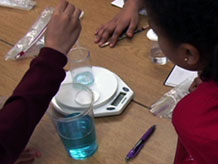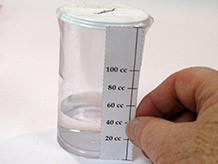How do oil and water compare?
2. Explore oil and water


As you distribute a tray of materials to each group, explain that groups will get 20 grams or 40 grams or 80 grams of oil. They will measure out equal amounts of water in a moment. At the end of the investigation, they will share their results and compare them.
Students fill the empty container with their assigned weight of water — 20 grams, 40 grams, or 80 grams. You may need to remind them to allow for the weight of the container (26g). Students then double-check that the weight of their two samples is the same; if it's not, they can add or remove some water using the pipette.
When they have equal weights of oil and water, students measure the volumes of the two samples using a measuring strip that they cut out of their notebooks. They record the volumes on the containers and make labeled drawings of the containers in their notebooks [How do oil and water compare?].
As students finish up their measurements, ask them to compare the way oil and water move by holding a container upright in each hand and gently swirling the liquids — no shaking or splashing! Have them record and share their observations.
- What property of oil or water do you think explains the difference in the way these two liquids move?
No oil spills! Though the containers of oil are capped and taped shut, students should keep them top-up at all times to prevent oil from leaking out. This is especially true when they are investigating the way the liquids move — no shaking!



